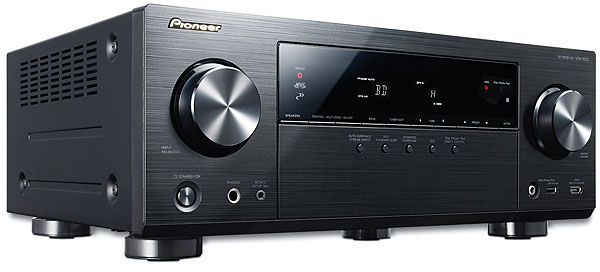Pioneer VSX-1123 AV Receiver Page 2
 Often a Dazzler
Often a Dazzler
Some receivers are slick chameleons that dazzle with their versatility, while others are more earthbound and limited by the sonic signature they impose on everything. This one was often the former and occasionally the latter. With movie content, it excelled. I was usually comfortable with the room correction’s sculpting of frequency balance and appreciated the way it enhanced imaging in the soundfield. With two-channel music, however, I found myself torn—as I often am—between the imaging gains of room correction versus the more natural frequency balance of the uncorrected sound.
In a movie like Lincoln, the receiver and MCACC got the fundamentals right. For battlefield effects, the amp provided the right bass weight down to the sub crossover, and the room correction tightened up the rumbling bass content of both music and effects. Vocal timbres were varied, not one-tone-fits-all, and that’s good. Only during the conflictedly triumphal “Battle Cry of Freedom,” with a large chorus backed by the Chicago Symphony Orchestra, did I feel that the receiver’s overall approach, the sum of its amplification and MCACC, was too cut and dried, not sufficiently multi-textured.
I watched a couple of movies about the historic Bin Laden mission back to back. In Seal Team Six, for the only time during all the demos, the room-corrected bass seemed swollen. A hairline adjustment of the sub volume fixed it, removing a modest bloat from the war drums constantly pervading the second half of the movie. MCACC’s soundfield-tightening properties enhanced the directionality of ballistic effects resounding through the soundfield.
By the time I got to Zero Dark Thirty—needless to say, the more compelling of the two—it was no surprise that the receiver could adeptly cope with exploding cars and other aggressive effects. It also did well with the timbral and spatial character of voices echoing in hard-walled interrogation rooms. What impressed me most, though, were the more subtle all-channel effects and the low-level resolution required to hold them together. In the movie’s more reflective moments, with all the extended cloak-and-dagger work that led up to the raid, the room correction consistently maintained soundfield integrity and laid on subliminal bass effects with a gentle hand. Hearing the nuance in this movie’s sound design was the greatest highlight of the movie sessions.
Still Fresh Cream
The Blu-ray release of Cream: Live at the Royal Albert Hall celebrates the 2005 reunion. This musical miracle—with much of the old vigor informed by an autumnal refinement—was well served by the receiver’s solid amplification and the room correction’s imaging prowess. To give Jack Bruce’s bass and Ginger Baker’s drums the prominence they deserved, I reversed the hairline sub level cut of the last movie selection. MCACC shaped the spatial properties of Bruce’s voice—still stirring after all these years—while losing none of his timbre, and was true to the shifting electric tones of Eric Clapton’s guitar lines.
The receiver got its toughest audition with a 24/176 HDtracks download of Mussorgsky’s "Pictures at an Exhibition" as performed by Fritz Reiner and the Chicago Symphony Orchestra. At its best, the material’s strong high-frequency content is like looking through a perfectly squeegeed window. But my first reaction was: Why doesn’t this feel perfect? Where’s the epiphany? It turned out that MCACC’s treble boost made it too much of a good thing. Only when I shifted to the pure analog mode—which removed both the room correction and the sub channel—did the strings take on a more balanced and full-bodied tone. What the presentation lost in imaging focus it gained in naturalness and listening comfort. Even with that adjustment, it was clear that the unvarnished amplification lacked the final degree of transparency some receivers approach when they pass the $1,000 mark. You still get what you pay for.

These distinctions faded when I moved on to more midrange-centered material. The vinyl release of The Jazz Years: 1948–1973, a celebration of Atlantic Records’ 25th anniversary, sounded great in any mode. MCACC had a slight edge in both overall imaging and bass focus. However, the pure analog mode had a more relaxed retro feel that evoked much of what I love about both the music and the era, especially the 1950s and ’60s material by Ray Charles, Jimmy Guiffre, Milt Jackson, the MJQ, Blakey/Monk, Mingus, Coltrane, and others. In pure mode, images were more vague but also larger. The verdict was six of one, half a dozen of the other: The vinyl and the Pioneer were made for each other regardless of listening mode.
As usual, Pioneer has delivered an almost state-of-the-art feature package in the VSX-1123 receiver. I say almost only because a growing number of manufacturers are providing Wi-Fi and Bluetooth as standard equipment as opposed to extra-cost options. If you want to incorporate an MHL or HTC smartphone into a home theater system, this may be just the receiver for you. Overall, performance is solid for a receiver at this price.
In some respects, Pioneer is its own toughest competitor. If your speakers aren’t especially demanding but you still want the MHL and HTC features, you can save a couple hundred bucks by stepping down to the slightly less powerful VSX-823. If your speakers are hungry for extra power, and you like to play ’em loud, step up to one of the pricier Class D3 models—the enhanced dynamics alone would be worth paying several hundred bucks more. Regardless of your needs, there’s probably a Pioneer receiver that will meet them.
























































